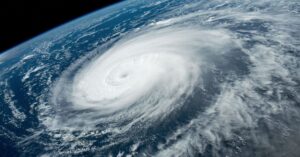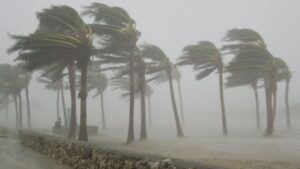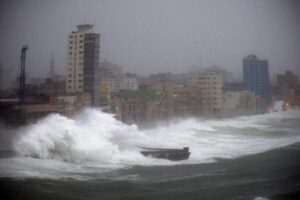Introduction:
Hurricanes are one of nature’s most powerful and destructive forces. These massive storms, known by different names in various parts of the world (hurricanes in the Atlantic and Northeast Pacific, typhoons in the Northwest Pacific, and cyclones in the South Pacific and Indian Ocean), captivate our fascination and fear due to their immense size and potential for devastation. In this essay, we will delve into the world of hurricanes, exploring when and where they occur and the scientific explanations behind their formation and intensity. By the end of this journey, we hope to gain a comprehensive understanding of these meteorological phenomena that shape our planet’s climate and geography.
What is a Hurricane?
Before we dive into the specifics, let’s start by defining what a hurricane is. A hurricane is a type of tropical cyclone characterized by its organized, circular system of thunderstorms, a low-pressure center (the eye), and sustained wind speeds of at least 74 miles per hour (119 kilometers per hour). These powerful storms originate over warm ocean waters, where they absorb heat and moisture, which fuels their growth and intensity.
When Do Hurricanes Occur?
Hurricane season varies depending on the region of the world. In the Atlantic Ocean, hurricane season officially runs from June 1st to November 30th. This period is marked by increased sea surface temperatures and favorable atmospheric conditions for hurricane formation. While hurricanes can occur outside of this timeframe, the majority of them develop during these months.
Where Do Hurricanes Occur?
a. Atlantic Ocean:
The Atlantic Ocean is one of the most well-known regions for hurricane development. Hurricanes in this region primarily affect the eastern coast of North America, the Gulf of Mexico, and the Caribbean islands. Some of the most devastating hurricanes in history, like Hurricane Katrina and Hurricane Sandy, originated in the Atlantic.

b. Eastern North Pacific:
The eastern North Pacific Ocean is another hotspot for hurricanes. This basin experiences its hurricane season from May 15th to November 30th, slightly earlier than the Atlantic. The Mexican coastline, including Baja California, is particularly vulnerable to hurricanes from this region.
c. Western North Pacific:
The western North Pacific, including the Philippines, Japan, and China, is prone to typhoons, which are essentially the same as hurricanes. Typhoons in this region can occur year-round but are most common from June to November.
d. South Pacific and Indian Ocean:
Cyclones in the South Pacific and Indian Ocean affect countries like Australia, India, and islands in the Indian Ocean. Cyclone seasons vary by region but generally occur during the warmer months when sea surface temperatures are high.
Why Do Hurricanes Occur?
Understanding why hurricanes occur requires delving into the intricate processes of atmospheric and oceanic dynamics. At the core of hurricane formation are several key factors:
a. Warm Ocean Water:
Hurricanes thrive on warm ocean water, typically with sea surface temperatures of at least 26 degrees Celsius (79 degrees Fahrenheit). Warm water acts as a source of heat and moisture, providing the energy necessary for the storm’s development.
b. Atmospheric Instability:
Hurricanes require a certain level of atmospheric instability to form. Warm, moist air near the ocean’s surface rises and cools, creating lower pressure. This process initiates the development of thunderstorms, which, if organized and sustained, can evolve into a hurricane.
c. Low-Pressure Systems:
A pre-existing weather disturbance, often a low-pressure system, can serve as a trigger for hurricane formation. When a low-pressure system interacts with warm, moist air over the ocean, it can lead to the development of a tropical cyclone.

d. The Coriolis Effect:
The Coriolis effect, caused by the Earth’s rotation, plays a crucial role in steering hurricanes. In the Northern Hemisphere, hurricanes rotate counterclockwise, while in the Southern Hemisphere, they rotate clockwise. This rotation gives hurricanes their characteristic spiral shape.
e. High Wind Shear:
While warm, moist air is essential for hurricane formation, high wind shear (a rapid change in wind speed and direction with altitude) can inhibit their development or intensification. Low wind shear allows for the vertical organization of the storm, promoting its growth.
The Life Cycle of a Hurricane
Hurricanes go through a distinct life cycle with various stages. These stages include tropical disturbance, tropical depression, tropical storm, and hurricane. Each stage is marked by specific characteristics and intensities. Understanding this life cycle is crucial for forecasting and monitoring these storms.
Categories of Hurricanes
Hurricanes are classified into categories based on their wind speed and potential for damage. The Saffir-Simpson Hurricane Wind Scale, ranging from Category 1 (weakest) to Category 5 (strongest), provides a standardized way to categorize hurricanes. We will explore the characteristics and impacts of each category.
The Impacts of Hurricanes
The impacts of hurricanes extend far beyond the immediate damage caused by high winds. Hurricanes can lead to storm surges, heavy rainfall, flooding, and even tornadoes. We will discuss these various impacts and their consequences for affected regions.
Hurricane Prediction and Mitigation
Predicting hurricanes and providing advance warning to vulnerable areas is essential for minimizing their impact. We will explore the methods and technologies used for hurricane prediction, including satellite imagery, computer models, and hurricane hunters. Additionally, we will discuss mitigation strategies, such as building codes and evacuation plans, aimed at reducing the loss of life and property during hurricanes.

Impact, Causes and Consequences of the World’s top five Hurricane Disasters.
1. Hurricane Katrina (2005):
Hurricane Katrina stands as one of the most devastating hurricanes in recent history. Striking the Gulf Coast of the United States in August 2005, it left a trail of destruction in its wake. The storm surge breached levees in New Orleans, resulting in catastrophic flooding. Over 1,800 people lost their lives, and tens of thousands were displaced. The inadequate response to the disaster raised concerns about disaster preparedness and response capabilities.
2. Typhoon Haiyan (Yolanda) (2013):
Typhoon Haiyan, known as Yolanda in the Philippines, was one of the most powerful tropical cyclones ever recorded. It struck the Philippines in November 2013, causing widespread devastation. With wind speeds exceeding 195 mph (315 km/h), it flattened entire communities, leaving over 6,000 people dead and displacing millions. The international community rallied to provide aid to the affected regions, highlighting the need for global cooperation in disaster relief efforts.
3. Hurricane Maria (2017):
Hurricane Maria made landfall in Puerto Rico in September 2017, leaving behind a trail of destruction. The island’s infrastructure was severely compromised, leading to prolonged power outages and limited access to clean water and medical care. The official death toll was initially underestimated but later revised to nearly 3,000. Maria exposed the vulnerabilities of territories in the Caribbean and the challenges in disaster recovery.
4. Cyclone Nargis (2008):
Cyclone Nargis struck Myanmar (Burma) in May 2008, causing widespread devastation and a significant loss of life. The cyclone’s powerful winds and storm surge inundated coastal areas, destroying homes and infrastructure. The Burmese government initially hesitated to accept international aid, leading to delays in relief efforts. Ultimately, Nargis claimed the lives of an estimated 138,000 people, making it one of the deadliest cyclones in history.
5. Hurricane Mitch (1998):
Hurricane Mitch is another catastrophic hurricane that made landfall in Central America in October 1998. It caused extensive flooding and landslides, particularly in Honduras and Nicaragua. Mitch claimed the lives of over 11,000 people and left hundreds of thousands homeless. The destruction of infrastructure, including roads and bridges, hampered rescue and relief efforts. Mitch highlighted the vulnerability of countries in the region to such extreme weather events

American Independence: History and Period of America
Conclusion:
In conclusion, hurricanes are awe-inspiring natural phenomena that have both fascinated and terrorized humanity for centuries. By understanding when, where, and why hurricanes occur, as well as their life cycle, categories, impacts, and the tools for prediction and mitigation, we can better prepare for and respond to these formidable storms. As we continue to grapple with the challenges posed by climate change, our knowledge of hurricanes will become increasingly vital in safeguarding communities and ecosystems from their destructive power.



















[…] What is the Hurricane: When, Where and Why They Occur […]
[…] What is the Hurricane: When, Where and Why They Occur […]
Hey there You have done a fantastic job I will certainly digg it and personally recommend to my friends Im confident theyll be benefited from this site
I do not even know how I ended up here but I thought this post was great I dont know who you are but definitely youre going to a famous blogger if you arent already Cheers
Hello Neat post Theres an issue together with your site in internet explorer would check this IE still is the marketplace chief and a large element of other folks will leave out your magnificent writing due to this problem
obviously like your website but you need to test the spelling on quite a few of your posts Several of them are rife with spelling problems and I to find it very troublesome to inform the reality on the other hand Ill certainly come back again
Fantastic site A lot of helpful info here Im sending it to some buddies ans additionally sharing in delicious And naturally thanks on your sweat
My brother suggested I might like this blog He was totally right This post actually made my day You can not imagine simply how much time I had spent for this info Thanks
I don’t think the title of your article matches the content lol. Just kidding, mainly because I had some doubts after reading the article.
Thank you for your sharing. I am worried that I lack creative ideas. It is your article that makes me full of hope. Thank you. But, I have a question, can you help me?
Bwer Pipes: The Ultimate Destination for Irrigation Excellence in Iraq: Elevate your farm’s irrigation capabilities with Bwer Pipes’ premium-quality products. Our innovative sprinkler systems and robust pipes are engineered for durability and efficiency, making them the ideal choice for Iraqi farmers striving for success. Learn More
I do not even know how I ended up here but I thought this post was great I dont know who you are but definitely youre going to a famous blogger if you arent already Cheers
I don’t think the title of your article matches the content lol. Just kidding, mainly because I had some doubts after reading the article.
I do agree with all the ideas you have introduced on your post They are very convincing and will definitely work Still the posts are very short for newbies May just you please prolong them a little from subsequent time Thank you for the post
Its like you read my mind You appear to know so much about this like you wrote the book in it or something I think that you can do with a few pics to drive the message home a little bit but instead of that this is excellent blog A fantastic read Ill certainly be back
I was recommended this website by my cousin I am not sure whether this post is written by him as nobody else know such detailed about my difficulty You are wonderful Thanks